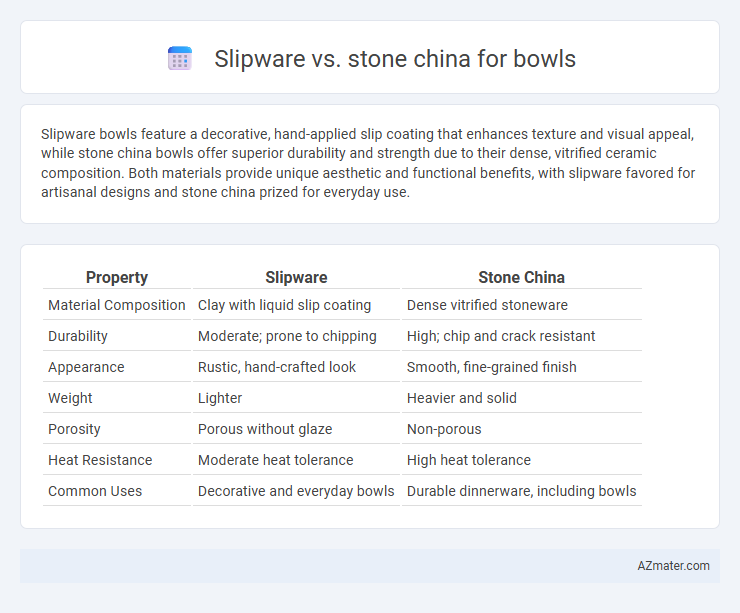Slipware bowls feature a decorative, hand-applied slip coating that enhances texture and visual appeal, while stone china bowls offer superior durability and strength due to their dense, vitrified ceramic composition. Both materials provide unique aesthetic and functional benefits, with slipware favored for artisanal designs and stone china prized for everyday use.
Table of Comparison
| Property | Slipware | Stone China |
|---|---|---|
| Material Composition | Clay with liquid slip coating | Dense vitrified stoneware |
| Durability | Moderate; prone to chipping | High; chip and crack resistant |
| Appearance | Rustic, hand-crafted look | Smooth, fine-grained finish |
| Weight | Lighter | Heavier and solid |
| Porosity | Porous without glaze | Non-porous |
| Heat Resistance | Moderate heat tolerance | High heat tolerance |
| Common Uses | Decorative and everyday bowls | Durable dinnerware, including bowls |
Introduction to Slipware and Stone China Bowls
Slipware bowls feature a decorative technique involving the application of liquid clay (slip) to their surface, creating unique patterns and textures that enhance both aesthetic appeal and tactile experience. Stone china bowls, made from durable vitrified stoneware, offer superior strength, chip resistance, and an elegant, smooth finish suitable for everyday use. The choice between slipware and stone china bowls depends on preferences for artisanal design versus practical durability and consistent performance.
Historical Origins and Development
Slipware bowls trace their origins back to ancient times, notably flourishing in medieval Europe where potters applied liquid clay slips to create decorative surfaces. Stone china, developed in the early 19th century in England, emerged as a durable alternative to porcelain, combining stoneware's robustness with fine white body characteristics. The historical development of slipware reflects traditional hand-crafted pottery techniques, while stone china represents industrial advancements in ceramic manufacturing during the Industrial Revolution.
Materials and Production Techniques
Slipware bowls feature a clay body coated with slip, a liquid mixture of clay and water, allowing for decorative surface designs achieved through dipping, trailing, or painting before firing. Stone china bowls, made from refined clay mixed with feldspar and quartz, undergo high-temperature firing that vitrifies the material, resulting in a dense, non-porous, and durable finish. The production of slipware emphasizes artistic surface decoration and slower firing processes, whereas stone china focuses on achieving strength and translucency through precise kiln temperature control.
Aesthetic Differences: Design and Patterns
Slipware bowls feature hand-applied slip decoration that creates intricate, fluid patterns with a rustic, artisanal appeal, emphasizing organic textures and earthy tones. Stone china bowls are characterized by smooth, glossy finishes and precise, often symmetrical designs that showcase vibrant, consistent colors and refined geometric or floral motifs. The aesthetic contrast lies in slipware's tactile, handcrafted look versus stone china's sleek, polished elegance, catering to different stylistic preferences in tableware.
Durability and Daily Use
Slipware bowls offer moderate durability with a decorative glaze that can chip or wear over time, making them suitable for light daily use but requiring careful handling. Stone china bowls provide superior durability due to their dense, vitrified body that resists chipping, cracking, and staining, making them ideal for heavy daily use in kitchens and restaurants. For long-term daily use, stone china outperforms slipware in terms of impact resistance and overall longevity.
Cost Comparison and Accessibility
Slipware bowls generally offer a more affordable option compared to stone china, as slipware production involves simpler materials and traditional handcrafting methods that reduce manufacturing costs. Stone china bowls, made from refined clay fired at higher temperatures, tend to be pricier due to their durability and premium finish, but they also enjoy wider availability in both retail and online stores. Accessibility favors slipware in artisanal markets and local pottery shops, while stone china is more commonly stocked by major kitchenware brands and large-scale distributors.
Care, Maintenance, and Longevity
Slipware bowls require gentle hand washing with mild soap to preserve their decorative glaze and prevent chipping, as they are more porous and less durable than stone china. Stone china bowls boast superior strength and are dishwasher safe, making them easier to maintain and more resistant to cracking and staining over time. Optimal longevity of slipware depends on careful handling and avoiding sudden temperature changes, whereas stone china's vitrified composition offers enhanced durability and daily usability.
Suitability for Culinary Purposes
Slipware bowls offer excellent heat retention and a rustic aesthetic, making them ideal for serving hot dishes and rustic culinary presentations. Stone china bowls provide superior durability and a non-porous surface, ensuring resistance to staining and ease of cleaning, which is perfect for everyday use and acidic foods. Both materials are microwave safe, but stone china's uniform glaze makes it more suitable for high-frequency culinary use and dishwasher cleaning.
Collectability and Market Value
Slipware bowls, characterized by their distinctive slip decoration and rustic aesthetic, appeal strongly to collectors interested in traditional pottery and historic craftsmanship, often commanding higher market values due to their artisanal uniqueness and limited production. Stone china bowls, noted for their durability and sleek, refined appearance, attract collectors seeking functional elegance and consistency, with market value influenced by brand reputation and condition rather than rarity. Collectability of slipware is typically driven by age, provenance, and decorative complexity, while stone china's market value depends more on demand in contemporary dining trends and manufacturer prestige.
Choosing the Right Bowl: Slipware or Stone China?
Slipware bowls offer unique hand-painted designs and a rustic texture, ideal for artisanal dining experiences, while stone china bowls provide exceptional durability, resistance to chipping, and a refined, smooth finish suitable for everyday use. Stone china typically features a denser composition with higher vitrification, making it more resistant to stains and thermal shock compared to the more porous slipware. Selecting the right bowl depends on whether you prioritize aesthetic character and traditional craftsmanship or long-lasting performance and ease of maintenance.

Infographic: Slipware vs Stone china for Bowl
 azmater.com
azmater.com